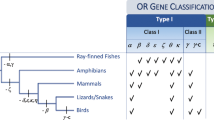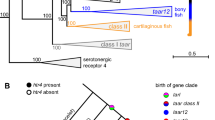Abstract
Interaction of olfactory receptor (OR) genes with environmental odors is regarded as the first step of olfaction. In this study, OR genes of two fish, medaka (Oryzias latipes) and stickleback (Gasterosteus aculeatus), were identified and an evolutional analysis was conducted. The selection pressure of different TM regions and complete coding region were compared. Three TM regions (TM4, TM5 and TM6) were found to have higher average Ka/Ks values, which might be partly caused by positive selection as suggested by subsequent positive selection analysis. Further analysis showed that many PTSs overlap, or are adjacent to previously deduced binding sites in mammals. These results support the hypothesis that binding sites of fish OR genes may evolved under positive selection.
Similar content being viewed by others
References
Firestein S. How the olfactory system makes sense of scents, Nature, 2001, 413: 211–218 10.1038/35093026, 1:CAS:528:DC%2BD3MXntVyjsrs%3D, 11557990
Mombaerts P. Genes and ligands for odorant, vomeronasal and taste receptors. Nat Rev Neurosci, 2004, 5: 263–278 10.1038/nrn1365, 1:CAS:528:DC%2BD2cXit12nu7s%3D, 15034552
Buck L, Axel R. A novel multigene family may encode odorant receptors: A molecular basis for odor recognition. Cell, 1991, 65: 175–187 10.1016/0092-8674(91)90418-X, 1:CAS:528:DyaK3MXmt1yqtLs%3D, 1840504
Zozulya S, Echeverri F, Nguyen T. The human olfactory receptor repertoire. Genome Biol, 2001, 2: RESEARCH0018 10.1186/gb-2001-2-6-research0018, 1:CAS:528:DC%2BD38Xit1Ojsbw%3D, 11423007
Young J M. Friedman C, Williams E M, et al. Different evolutionary processes shaped the mouse and human olfactory receptor gene families. Hum Mol Genet, 2002, 11: 535–546 10.1093/hmg/11.5.535, 1:CAS:528:DC%2BD38XitlWisbY%3D, 11875048
Zhang X, Firestein S. The olfactory receptor gene superfamily of the mouse. Nat Neurosci, 2002, 5: 124–133 1:CAS:528:DC%2BD38XhtFGmurY%3D, 11802173
Niimura Y, Nei M. Evolution of olfactory receptor genes in the human genome. Proc Natl Acad Sci USA, 2003, 100: 12235–12240 10.1073/pnas.1635157100, 1:CAS:528:DC%2BD3sXotlGksrk%3D, 14507991
Ngai J, Dowling M M, Buck L, et al. The family of genes encoding odorant receptors in the channel catfish. Cell, 1993, 72: 657–666 10.1016/0092-8674(93)90396-8, 1:CAS:528:DyaK3sXisVyru7w%3D, 7916654
Alioto T S, Ngai J. The odorant receptor repertoire of teleost fish. BMC Genomics, 2005, 6: 173 10.1186/1471-2164-6-173, 16332259
Niimura Y, Nei M. Evolutionary dynamics of olfactory receptor genes in fishes and tetrapods, Proc Natl Acad Sci USA, 2005, 102: 6039–6044 10.1073/pnas.0501922102, 1:CAS:528:DC%2BD2MXkt1Cmu7k%3D, 15824306
Niimura Y, Nei M. Evolutionary changes of the number of olfactory receptor genes in the human and mouse lineages. Gene, 2005, 346: 23–28 10.1016/j.gene.2004.09.027, 1:CAS:528:DC%2BD2MXitV2hurk%3D, 15716099
Quignon P, Kirkness E, Cadieu E, et al. Comparison of the canine and human olfactory receptor gene repertoires. Genome Biol, 2003, 4: R80 10.1186/gb-2003-4-12-r80, 14659017
Olender T, Fuchs T, Linhart C, et al. The canine olfactory subgenome, Genomics. 2004, 83: 361–372 10.1016/j.ygeno.2003.08.009, 1:CAS:528:DC%2BD2cXhtVegtLY%3D, 14962662
Gilad Y, Wiebe V, Przeworski M, et al. Loss of olfactory receptor genes coincides with the acquisition of full trichromatic vision in primates. PLoS Biol, 2004, 2: E5 10.1371/journal.pbio.0020005, 14737185
Niimura Y, Nei M. Evolutionary dynamics of olfactory and other chemosensory receptor genes in vertebrates. Hum Genet, 2006, 51: 505–517 10.1007/s10038-006-0391-8, 1:CAS:528:DC%2BD28XmtFCgu7c%3D
Pilpel Y, Lancet D. The variable and conserved interfaces of modeled olfactory receptor proteins. Protein Sci, 1999, 8: 969–977 10.1110/ps.8.5.969, 1:CAS:528:DyaK1MXjtFGmsLw%3D, 10338007
Man O, Gilad Y, Lancet D. Prediction of the odorant binding site of olfactory receptor proteins by human-mouse comparisons. Protein Sci, 2004, 13: 240–254 10.1110/ps.03296404, 1:CAS:528:DC%2BD2cXhsFWhsQ%3D%3D, 14691239
Hughes A L, Nei M. Pattern of nucleotide substitution at major histocompatibility complex class I loci reveals overdominant selection. Nature, 1988, 335: 167–170 10.1038/335167a0, 1:CAS:528:DyaL1cXlvVCktrY%3D, 3412472
Hughes A L, Nei M. Nucleotide substitution at major histocompatibility complex class II loci: Evidence for overdominant selection, Proc Natl Acad Sci USA, 1989, 86: 958–962 10.1073/pnas.86.3.958, 1:CAS:528:DyaL1MXhsV2jsbs%3D, 2492668
Gilad Y, Man O, Glusman G. A comparison of the human and chimpanzee olfactory receptor gene repertoires. Genome Res, 2005, 15: 224–230 10.1101/gr.2846405, 1:CAS:528:DC%2BD2MXhsVKgur4%3D, 15687286
Kondo R, Kaneko S, Sun H, et al. Diversification of olfactory receptor genes in the Japanese medaka fish, Oryzias latipes. Gene, 2002, 282: 113–120 10.1016/S0378-1119(01)00843-5, 1:CAS:528:DC%2BD38XnvFSgtw%3D%3D, 11814683
Altschul S F, Madden T L, Schaffer A A, et al. Gapped BLAST and PSI-BLAST: A new generation of protein database search programs. Nucleic Acids Res, 1997, 25: 3389–3402 10.1093/nar/25.17.3389, 1:CAS:528:DyaK2sXlvFyhu7w%3D, 9254694
Birney E, Clamp M, Durbin R. GeneWise and Genomewise. Genome Res, 2004, 14: 988–995 10.1101/gr.1865504, 1:CAS:528:DC%2BD2cXjvFyku7c%3D, 15123596
Katoh K, Toh H. Recent developments in the MAFFT multiple sequence alignment program. Brief Bioinform, 2008, 9: 286–298 10.1093/bib/bbn013, 1:CAS:528:DC%2BD1cXpt1artrs%3D, 18372315
Kumar S, Tamura K, Nei M. MEGA3: Integrated software for Molecular Evolutionary Genetics Analysis and sequence alignment. Brief Bioinform, 2004, 5: 150–163 10.1093/bib/5.2.150, 1:CAS:528:DC%2BD2cXntFGqu7s%3D, 15260895
Guindon S, Gascuel O. A simple, fast, and accurate algorithm to estimate large phylogenies by maximum likelihood. Syst Biol, 2003, 52: 696–704 10.1080/10635150390235520, 14530136
Zhang Z, Li J, Zhao X Q, et al. KaKs_Calculator: calculating Ka and Ks through model selection and model averaging, Genomics proteomics & bioinformatics, Beijing Genomics Institute 2006, 4: 259–263 1:CAS:528:DC%2BD2sXktleisLc%3D
Nei M, Gojobori T. Simple methods for estimating the numbers of synonymous and nonsynonymous nucleotide substitutions. Mol Biol Evol, 1986, 3: 418–426 1:CAS:528:DyaL28Xmt1aisbs%3D, 3444411
Yang Z. PAML: A program package for phylogenetic analysis by maximum likelihood. Comput Appl Biosci, 1997, 13: 555–556 1:CAS:528:DyaK2sXntlGnu7s%3D, 9367129
Yang Z, Nielsen R, Goldman N, et al. Codon-substitution models for heterogeneous selection pressure at amino acid sites, Genetics, 2000, 155: 431–449 1:CAS:528:DC%2BD3cXjslKhtb4%3D, 10790415
Thompson J D, Gibson T J, Plewniak F, et al. The CLUSTAL_X windows interface: Flexible strategies for multiple sequence alignment aided by quality analysis tools. Nucleic Acids Res, 1997, 25: 4876–4882 10.1093/nar/25.24.4876, 1:CAS:528:DyaK1cXntFyntQ%3D%3D, 9396791
Yang Z, Nielsen R. Codon-substitution models for detecting molecular adaptation at individual sites along specific lineages. Mol Biol Evol, 2002, 19: 908–917 1:CAS:528:DC%2BD38Xks1Ojtbk%3D, 12032247
Zhang J, Nielsen R, Yang Z. Evaluation of an improved branch-site likelihood method for detecting positive selection at the molecular level. Mol Biol Evol, 2005, 22: 2472–2479 10.1093/molbev/msi237, 1:CAS:528:DC%2BD2MXht1KgtLbM, 16107592
Glusman G, Yanai I, Rubin I, et al. The complete human olfactory subgenome. Genome Res, 2001, 11: 685–702 10.1101/gr.171001, 1:CAS:528:DC%2BD3MXjs1Wmur4%3D, 11337468
Freitag J, Beck A, Ludwig G, et al. On the origin of the olfactory receptor family: receptor genes of the jawless fish (Lampetra fluviatilis). Gene, 1999, 226: 165–174 10.1016/S0378-1119(98)00575-7, 1:CAS:528:DyaK1MXhtFantL8%3D, 10084886
Cao Y, Oh B C, Stryer L. Cloning and localization of two multigene receptor families in goldfish olfactory epithelium. Proc Natl Acad Sci USA, 1998, 95: 11987–11992 10.1073/pnas.95.20.11987, 1:CAS:528:DyaK1cXmsV2ht74%3D, 9751777
Irie-Kushiyama S, Asano-Miyoshi M, Suda T, et al. Identification of 24 genes and two Pseudogenes coding for olfactory receptors in Japanese loach, classified into four subfamilies: A putative evolutionary process for fish olfactory receptor genes by comprehensive phylogenetic analysis. Gene, 2004, 325: 123–135 10.1016/j.gene.2003.10.011, 1:CAS:528:DC%2BD3sXpvFCjsrY%3D, 14697517
Floriano W B, Vaidehi N, Goddard W A 3rd, et al. Molecular mechanisms underlying differential odor responses of a mouse olfactory receptor. Proc Natl Acad Sci USA, 2000, 97: 10712–10716 10.1073/pnas.97.20.10712, 1:CAS:528:DC%2BD3cXnt1aiurg%3D, 11005853
Katada S, Hirokawa T, Oka Y, et al. Structural basis for a broad but selective ligand spectrum of a mouse olfactory receptor: Mapping the odorant-binding site. J Neurosci, 2005, 25: 1806–1815 10.1523/JNEUROSCI.4723-04.2005, 1:CAS:528:DC%2BD2MXhvFGqu7Y%3D, 15716417
Ballesteros J A, Shi L, Javitch J A. Structural mimicry in G protein-coupled receptors: implications of the high-resolution structure of rhodopsin for structure-function analysis of rhodopsin-like receptors. Mol Pharmacol, 2001, 60: 1–19 1:CAS:528:DC%2BD3MXks1Crt70%3D, 11408595
Singer M S. Analysis of the molecular basis for octanal interactions in the expressed rat 17 olfactory receptor. Chem Senses, 2000, 25: 155–165 10.1093/chemse/25.2.155, 1:CAS:528:DC%2BD3cXjtF2gt7c%3D, 10781022
Vaidehi N, Floriano W B, Trabanino R, et al. Prediction of structure and function of G protein-coupled receptors. Proc Natl Acad Sci USA, 2002, 99: 12622–12627 10.1073/pnas.122357199, 1:CAS:528:DC%2BD38XnvFGhsr4%3D, 12351677
Francino M P. An adaptive radiation model for the origin of new gene functions. Nat Genet, 2005, 37: 573–577 10.1038/ng1579, 1:CAS:528:DC%2BD2MXksFeisLo%3D, 15920518
Author information
Authors and Affiliations
Corresponding author
Rights and permissions
About this article
Cite this article
Chen, M., Peng, Z. & He, S. Olfactory receptor gene family evolution in stickleback and medaka fishes. Sci. China Life Sci. 53, 257–266 (2010). https://doi.org/10.1007/s11427-010-0025-4
Received:
Accepted:
Published:
Issue Date:
DOI: https://doi.org/10.1007/s11427-010-0025-4




